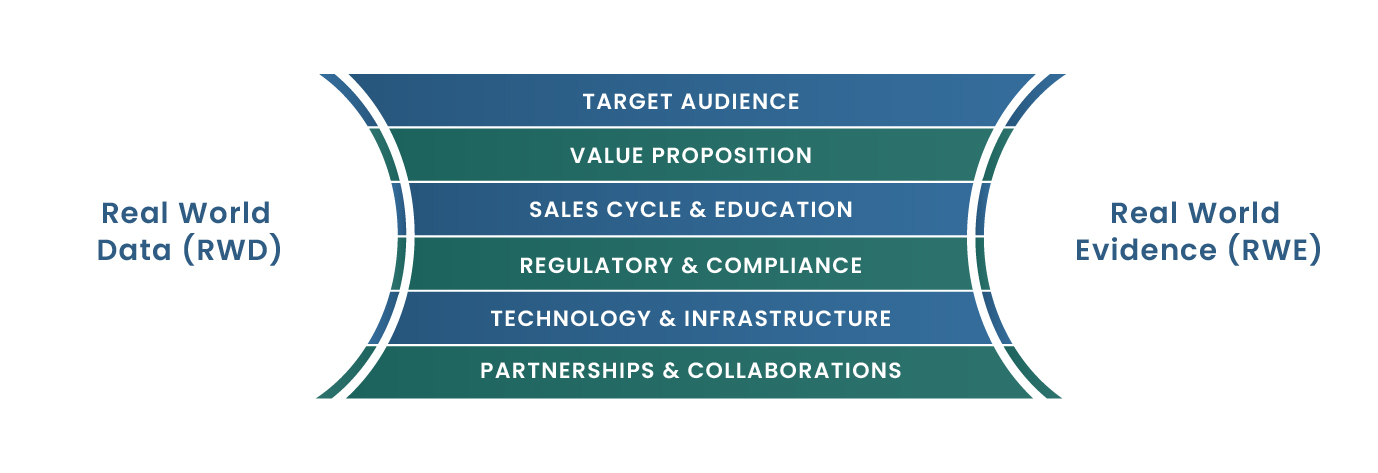In today’s rapidly evolving healthcare world, using data to enhance treatments, guide decisions, and improve patient outcomes is more important than ever. Real-World Data (RWD) and Real-World Evidence (RWE) are key players in driving these changes. While they’re often used interchangeably, they actually refer to different stages in the data process, each needing its own approach when it comes to marketing. Let’s dive into the main differences between the strategies used to bring RWD and RWE solutions to the market.
Understanding RWD & RWE
Real-World Data (RWD)
This refers to data gathered from real-world sources. It includes information like patient details from electronic health records (EHRs), social media, insurance claims, wearable devices, and patient registries. Real-world data (RWD) is often in its raw form or only lightly processed, offering insights into things like patient demographics, medical histories, treatment outcomes, and much more
Real-World Evidence (RWE)
Using real-world data (RWD) to uncover trends, insights, or answers to important healthcare questions is known as real-world evidence, or RWE. To delve deeply into the data, this usually entails the use of tools like machine learning, statistics, and other analytics. Finding out how effective a drug is, what treatment trends are emerging, or how healthcare outcomes are evolving over time are some examples of the objectives.
Key Differences in Go-To-Market (GTM) Strategy

- Target Audience
RWD GTM Strategy
- The target audience includes data scientists, healthcare researchers, and organisations seeking to acquire patient data for internal analysis
- Since RWD offers unprocessed patient data, its customers are usually businesses such as pharmaceutical companies, medical facilities, or university researchers who possess the resources and know-how to analyse and interpret this data on their own
- Since RWD offers unprocessed patient data, its customers are usually businesses such as pharmaceutical companies, medical facilities, or university researchers who possess the resources and know-how to analyse and interpret this data on their own
RWE GTM Strategy
- Payers, pharmaceutical firms, regulatory bodies, and healthcare decision-makers seeking practical insights make up the target audience
- RWE influences clinical decision-making, market access, regulatory submissions, and even reimbursement decisions.
- The target audiences in this case are those who need results-driven evidence to guide strategic decisions, and the emphasis is on how RWE can enhance clinical trials, provide evidence of treatment efficacy, or impact policy decisions.
- Value Proposition
RWD GTM Strategy
- RWD's volume, richness, and diversity are frequently its main selling points - A variety of settings can serve as data sources, guaranteeing that they accurately depict actual treatment situations
- Stress the adaptability and personalisation of data packages - RWD may be used in conjunction with other datasets that many clients already have
RWE GTM Strategy
- The value proposition for RWE revolves around delivering insights that directly influence decisions - RWE addresses the ‘why’ and ‘how’ of treatment effectiveness and outcomes
- It can help demonstrate the value of a treatment, guide drug development decisions, or shape public health policy - In contrast to raw data, the GTM for RWE is more focused on how that data leads to better, more informed decisions
- Sales Cycle & Education
RWD GTM Strategy
- Selling patient data frequently entails informing the client about the methods used to collect the data, its accuracy, and how it can be tailored to meet their unique requirements
- A strong emphasis is placed on educating the market about data governance, privacy issues, and ensuring that the data is fit for purpose
RWE GTM Strategy
- RWE's sales cycle typically concentrates on offering tangible results that specifically address customer pain points
- There’s a clear link to ROI or measurable impact, especially when RWE can help justify treatment efficacy, market access, or regulatory approvals - the key is showcasing how RWE can directly improve clinical or operational outcomes
- Regulatory & Compliance Considerations
RWD GTM Strategy
- As RWD typically includes sensitive health information, ensuring compliance with data privacy laws (like HIPAA or GDPR) is crucial
- The GTM strategy should also focus on transparency regarding how data is collected, cleaned, and anonymized to meet regulatory requirements
RWE GTM Strategy
- When RWE is used to support regulatory submissions (e.g., FDA approval), the GTM strategy must emphasize the validity and reliability of the evidence
- Building confidence in the techniques used to analyse the RWD and making sure the findings are strong enough to stand up to regulatory scrutiny may be necessary to achieve this - case studies or recorded success stories of RWE influencing policy or regulatory outcomes may be required
- Technology & Infrastructure
RWD GTM Strategy
- Businesses providing RWD should concentrate on the infrastructure and scalability of their data collection techniques, which frequently entails advocating for a flexible API for simple integration with other data systems
- The GTM strategy should highlight data interoperability, platform capabilities, and ease of access
RWE GTM Strategy
- RWE solutions often come with built-in analytics, visualization tools, or AI models that can quickly generate insights from the data
- Particularly in decision-making and evidence generation, the GTM approach should highlight the strength of analytics capabilities and how these tools produce actionable insights
- Partnership & Collaboration
RWD GTM Strategy
- Academic institutions, medical facilities, and other research-focused organisations are likely to form partnerships in the RWD market - These partnerships focus on the collection, validation, and exchange of data
- The GTM strategy should emphasize collaboration in data collection, data-sharing agreements, and the ability to meet specific data needs
- Life science companies may also seek RWD partnerships to build registries
RWE GTM Strategy
- RWE solutions often require collaboration with pharmaceutical companies, healthcare providers, regulatory bodies, and insurers - These partnerships focus on ensuring the data-driven insights have direct, actionable impact on patient care, drug approval processes, or reimbursement
- The GTM strategy must highlight how partnerships can help ensure RWE results align with real-world clinical needs and regulatory requirements

Conclusion
RWD and RWE solutions cater to different needs in the healthcare industry, which affects their target market, value proposition, sales strategy, and regulatory focus. RWD is all about providing raw patient data that helps fuel deeper research and analysis, while RWE focuses on delivering actionable insights that can directly influence healthcare decisions. For companies in these fields, it’s crucial to tailor their marketing, sales, and overall strategy to these differences in order to successfully tap into their respective markets. By understanding these distinctions, businesses can position their solutions to better address the specific needs of healthcare clients and beyond.
Insights That Drive Impact
Healthcare is evolving faster than ever — and those who adapt are the ones who will lead the change.
Stay ahead of the curve with our in-depth insights, expert perspectives, and a strategic lens on what’s next for the industry.




